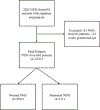Urgent Follow-up after Outpatient Nonstress Tests and the Potential for Fetal Monitoring at Home
- PMID: 37774744
- PMCID: PMC11061263
- DOI: 10.1055/a-2184-1294
Urgent Follow-up after Outpatient Nonstress Tests and the Potential for Fetal Monitoring at Home
Abstract
Objective: This study aimed to measure the proportion of patients needing urgent clinical follow-up after an abnormal outpatient nonstress test (NST). We further sought to capture the patient perspective on the acceptability of performing NSTs at home.
Study design: A retrospective cohort study was performed over a 2-year period to determine the frequency of abnormal NSTs in a hospital-based, antepartum testing unit in patients greater than or equal to 32 weeks' gestation. The proportion of patients who delivered within 24 hours of an abnormal NST was also determined. A cross-sectional, web-based patient survey was conducted to obtain insight into the patient's comfort level with potentially performing NSTs at home.
Results: The chart review yielded 665 patients who underwent 2,122 NSTs at greater than or equal to 32 weeks. Of the 2,122 NSTs, 111 were categorized as abnormal and required urgent clinical follow-up, or 5.2% (95% confidence interval [CI] 4.3, 6.3%). Of the 665 patients, 13 delivered within 24 hours of an abnormal NST, or 2.0% (95% CI 1.0, 3.3%). In the web-based survey, the proportion of respondents who would feel comfortable or very comfortable conducting NSTs at home was 87/125, or 69.6% (95% CI 60.9, 77.1%).
Conclusion: This study revealed that 5.2% of NSTs performed in a hospital-based antepartum testing unit were abnormal and required urgent clinical follow-up. Of the patients being followed in the antepartum testing unit, 2.0% delivered within 24 hours of an abnormal NST. The majority of the survey respondents indicated they would feel comfortable performing NSTs at home. The present study adds important information regarding the risks and benefits of NSTs at home.
Key points: · Telehealth for NSTs offers advantages over in-person NSTs.. · The proportion of NSTs that need urgent follow-up was 5.2%.. · A majority of patients are interested in telehealth for NSTs.. · Guidelines are needed before adoption of telehealth for NSTs..
Thieme. All rights reserved.
Conflict of interest statement
None declared.
Figures
Similar articles
-
Antenatal fetal surveillance of women with severe obesity.J Matern Fetal Neonatal Med. 2022 Dec;35(25):9288-9293. doi: 10.1080/14767058.2022.2026919. Epub 2022 Jan 13. J Matern Fetal Neonatal Med. 2022. PMID: 35026965
-
Does Doppler-detected fetal movement decrease the incidence of nonreactive nonstress tests?Obstet Gynecol. 1993 Dec;82(6):999-1003. Obstet Gynecol. 1993. PMID: 8233279
-
The nonreactive nonstress test: predictive value for neonatal anemia in the isoimmunized pregnancy.Obstet Gynecol. 1996 Sep;88(3):364-7. doi: 10.1016/0029-7844(96)00180-9. Obstet Gynecol. 1996. PMID: 8752240
-
Fetal well-being: nonimaging assessment and the biophysical profile.Semin Roentgenol. 1991 Jan;26(1):21-31. doi: 10.1016/0037-198x(91)90037-o. Semin Roentgenol. 1991. PMID: 2006429 Review.
-
Assessing the diagnostic accuracy and efficacy of selected antepartum fetal surveillance techniques.Obstet Gynecol Surv. 1986 Mar;41(3):121-41. doi: 10.1097/00006254-198603000-00001. Obstet Gynecol Surv. 1986. PMID: 3515252 Review.
References
-
- Antepartum Fetal Surveillance: ACOG Practice Bulletin, Number 229. Obstet Gynecol. 2021;137(6):e116–e127. - PubMed
-
- Manning FA, Platt LD. Maternal hypoxemia and fetal breathing movements. Obstet Gynecol. 1979;53(6):758–760. - PubMed
-
- Tamaru S, Jwa SC, Ono Y, et al. Feasibility of a mobile cardiotocogram device for fetal heart rate self-monitoring in low-risk singleton pregnant women. J Obstet Gynaecol Res. 2021. - PubMed
Publication types
MeSH terms
Grants and funding
LinkOut - more resources
Full Text Sources


